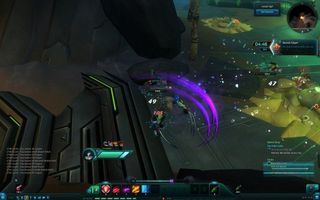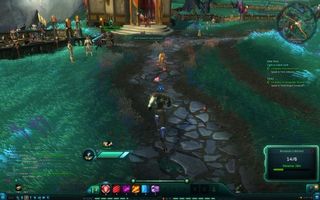Wildstar review in progress part one: character creation and starting areas

Those enemies don't flag all of their attacks—if you're fighting one-on-one, you'll sustain the occasional unannounced hit— but red cones, lines and circles will pre-empt their special abilities, making combat a responsive and engaging game of position and manoeuvring. It also offers a great degree of diversity. I'll touch on this more in a future update, when I've had the chance to see the scope of each class, but already I can start to spec my Stalker along DPS, tanking and hybrid paths. Just looking at the AMP screen—the customisable grid of passive stat boosts—confirms that theorycrafters will be in their element.
For all the clever touches that go into the combat system, its best part is something far simpler: it has a mega-kill announcer. As you rack up kills in quick succession, a voice is intoning "double-kill," "triple-kill," "super-kill", etc. It turns out that this is the perfect fit for an MMO, and it his an effect on how I play. I've started taking on bigger groups, just to hear an excitable man tell me how well I'm doing. Given how abstracted MMO combat can be, feedback is essential to giving it a sense of weight and import. It's in this area that Wildstar absolutely excels.
It's at the end of Levian Bay where the well-honed questing slightly falters. Before leaving the zone, a public event quest asks players to take down a giant military robot. Only, there's no robot to be found. It's been killed, and now a group of us are waiting for the respawn. In fact, we need a couple of respawns, because the thing goes down quickly enough that not everybody gets a chance to participate. For the most part, Wildstar is generous enough in its rewards, assigning credit for participating in kills. But at times, it feels like you're in direct competition with other players—a problem more keenly felt in the next zone.
Ellevar

The highest praise I can give to Wildstar's questing is that, in the 8-or-so hours I've spent in Ellevar, I've not resorted to watching Netflix on my second screen. The same can't be said of the last time I levelled in an MMO, back in The Elder Scrolls Online beta. Wildstar's quests follow the standard archetypes—kill things, collect things or activate things—and are collected from a variety of NPC camps throughout the world. But its zones don't feel restrictive, and, if you're prepared to risk some tougher enemies, exploration is encouraged.
The key difference is that, while you may be asked to kill a certain enemy, you're not asked to kill a certain amount of them. Instead, a percentage bar is filled, and the amount it increases is dependent on the difficulty of the enemy that you're fighting. That small difference has helped keep me engaged with the world.
I'm not running through the zone, killing things on autopilot. That's partly down to the nature of the combat system, but also because each monster type will also have special Prime variants. These are super-tough versions of that enemy that carry a resistance to crowd control effects. It's kept me aware of the players around me, and I've started positioning myself in a way that flags to passing players that, "hey dude, this is happening".

But where some systems promote group play, others seem to actively punish it. Regularly, as you travel through the world, you'll activate timed challenges. These can be for a variety of things, but the most common is to fill a percentage bar within a timed limit. It's not just that your percentage gain is harmed if other players help with a kill, but also that players will naturally reduce the number of monsters in an area. It's disheartening to be stuck waiting for a respawn while a timer ticks down.
Comic deals, prizes and latest news
Sign up to get the best content of the week, and great gaming deals, as picked by the editors.
Worse are those quests that require a mission-specific skill be used. In one, I had to set a trap for some wolf-things outside the main Dominion settlement. More than once, as I was deploying the trap, some unaware player would come along and kill the monster I was preparing for. When so much of the game is so enjoyable, it's these annoyances that start to stand out.
These issues aside, I've got a full quest log that stands as a testament to the lack of grind. My current to-do list contains a range of missions both under and over my current level—as well as a couple of group missions, collected from bounty boards—all achievable if I'm up for the challenge. In addition are the path quests, the completion of which ranks up a separate level that unlocks bonuses toward your chosen profession.

I was originally worried about the paths. You choose one of four roles which each offer a different flavour of ongoing background missions. The settler builds things to help other players, the soldier fights waves of enemies at certain points in the world, the scientist maps the world by scanning flora and the explorer gets jumping puzzles. I played as the scientist during the beta. Personally, I don't care enough about lore to want to scan every plant and animal in Carbine's fiction. I do care about jumping about like an idiot, and so the jumping puzzles and tracking quests of my current character's explorer path make for a nice change when I need a break from the murder.
Perhaps the one downside of the explorer path is that, so far, I'm not stunned by Wildstar's environments. The chunky, cartoon-like art style seems to work better in its interiors, and I've found much of the last two zones somewhat unremarkable. It's not a blanket criticism, given how little of the full game I've seen. I'm hoping that later areas can offer more spectacle.
Also, thanks to the Explorer missions, this happened:

That's me chasing a naked rabbit-thing to a Benny Hill-esque tune. My notes from this bit of the game read only: "silly". I didn't mean it as a criticism.
I'm level 13 now, and fast approaching player housing, Adventures and, eventually, dungeons. As much as I've had fun with the general questing, it's these group scenarios that really interest me. That was further confirmed last night, when I was invited to a public raid against Ellevar's Hoarding Stemdragon boss. Designed for around 20 people, we instead tackled it with 11. As a result, it was a gruelling 45 minute battle, but confirmed that the combat signalling works best when paired with big bosses. Throughout, it would send out special attack patterns, requiring a level of concentration and awareness that few MMOs would ask of such a low-level encounter. It was a strong statement of the game's approach to group activities, and I look forward to seeing more.
Read part two for Phil's experiences with Shiphand missions, player housing and PvP Battlegrounds.

Phil has been writing for PC Gamer for nearly a decade, starting out as a freelance writer covering everything from free games to MMOs. He eventually joined full-time as a news writer, before moving to the magazine to review immersive sims, RPGs and Hitman games. Now he leads PC Gamer's UK team, but still sometimes finds the time to write about his ongoing obsessions with Destiny 2, GTA Online and Apex Legends. When he's not levelling up battle passes, he's checking out the latest tactics game or dipping back into Guild Wars 2. He's largely responsible for the whole Tub Geralt thing, but still isn't sorry.
Most Popular

